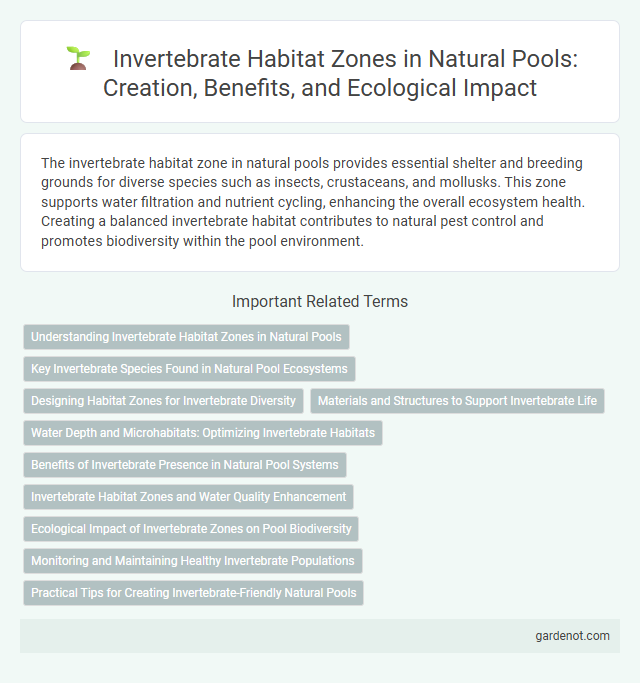The invertebrate habitat zone in natural pools provides essential shelter and breeding grounds for diverse species such as insects, crustaceans, and mollusks. This zone supports water filtration and nutrient cycling, enhancing the overall ecosystem health. Creating a balanced invertebrate habitat contributes to natural pest control and promotes biodiversity within the pool environment.
Understanding Invertebrate Habitat Zones in Natural Pools
Invertebrate habitat zones in natural pools provide essential environments for diverse species such as dragonfly larvae, freshwater shrimp, and water beetles. These zones vary based on factors like water depth, vegetation density, and substrate type, creating microhabitats that support feeding, breeding, and shelter. Understanding these habitat zones is crucial for maintaining ecological balance and biodiversity in natural pool ecosystems.
Key Invertebrate Species Found in Natural Pool Ecosystems
Key invertebrate species found in natural pool ecosystems include freshwater snails, dragonfly larvae, and water beetles, each playing a critical role in maintaining ecological balance. Dragonfly larvae act as predators controlling mosquito populations, while freshwater snails contribute to algae regulation and nutrient cycling. Water beetles are important scavengers and prey for fish and amphibians, enhancing biodiversity within the invertebrate habitat zone.
Designing Habitat Zones for Invertebrate Diversity
Designing habitat zones within a natural pool requires creating diverse microhabitats such as submerged vegetation, gravel substrates, and shallow margins to support a wide range of invertebrate species. Incorporating variations in water depth and plant types encourages colonization by aquatic insects, mollusks, and crustaceans, enhancing ecological balance and water quality. Structured habitat zones increase biodiversity, providing essential niches for larval development and feeding grounds critical to sustaining the pool's natural ecosystem.
Materials and Structures to Support Invertebrate Life
Natural pools incorporate diverse materials such as submerged logs, leaf litter, and gravel beds to create ideal habitats for invertebrates. These structures provide shelter, breeding grounds, and feeding surfaces essential for sustaining aquatic insects, crustaceans, and mollusks. Careful placement of varied substrates enhances biodiversity by mimicking natural ecosystems within the Invertebrate Habitat Zone.
Water Depth and Microhabitats: Optimizing Invertebrate Habitats
Water depth in the invertebrate habitat zone of a natural pool is crucial for supporting diverse species, with shallow areas promoting oxygen-rich environments ideal for larvae and microcrustaceans. Varied microhabitats such as submerged vegetation, leaf litter, and sediment layers enhance shelter and feeding opportunities, increasing biodiversity. Optimizing these conditions through gradual depth gradients and structural complexity fosters resilient invertebrate communities vital for ecosystem balance.
Benefits of Invertebrate Presence in Natural Pool Systems
Invertebrate presence in natural pool systems enhances ecological balance by supporting nutrient cycling and organic matter decomposition. These organisms serve as a vital food source for amphibians, birds, and fish, promoting biodiversity and ecosystem stability. Their activities improve water quality by breaking down detritus and controlling algae growth, contributing to a healthier aquatic environment.
Invertebrate Habitat Zones and Water Quality Enhancement
Invertebrate habitat zones in natural pools provide essential environments for diverse species such as aquatic insects, mollusks, and crustaceans that contribute to biological filtration and nutrient cycling. These zones enhance water quality by promoting the breakdown of organic matter and supporting ecosystems that regulate algae growth and maintain oxygen levels. Integrating varied substrate types and vegetation within invertebrate habitat zones optimizes the natural purification processes crucial for maintaining clear, balanced water.
Ecological Impact of Invertebrate Zones on Pool Biodiversity
Invertebrate habitat zones within natural pools significantly enhance biodiversity by providing essential microhabitats that support diverse aquatic species, including insects, mollusks, and crustaceans. These zones contribute to nutrient cycling and water purification processes, fostering a balanced ecosystem that sustains both flora and fauna. The presence of varied invertebrate communities also promotes predator-prey dynamics, increasing the overall ecological resilience and stability of the natural pool environment.
Monitoring and Maintaining Healthy Invertebrate Populations
Regular monitoring of invertebrate populations in the habitat zone involves assessing species diversity, abundance, and water quality parameters to ensure ecological balance. Maintaining healthy invertebrate communities requires controlling pollutants, preventing habitat disruption, and promoting native vegetation that supports life cycles. Data-driven adjustments to environmental conditions help sustain essential functions like nutrient cycling and food web stability in natural pools.
Practical Tips for Creating Invertebrate-Friendly Natural Pools
Creating an invertebrate-friendly natural pool requires incorporating diverse aquatic plants like water lilies, reeds, and submerged vegetation that provide shelter and breeding grounds. Maintain gradual slope zones with varied depths to support different invertebrate species and enhance water quality through natural filtration. Avoid chemical treatments and introduce native stone or wood structures to mimic natural habitats, promoting biodiversity and ecosystem balance.
Invertebrate habitat zone Infographic

 gardenot.com
gardenot.com